Small baby rooms can feel crowded fast. If you live in a tiny apartment, space is precious from the moment you bring home a baby. You want a calm, safe place for sleep, diaper changes, and a little play, without a room that feels boxed in. This reality is what pushed me to write this post.
1. Opt for a Crib That Doubles as a Changing Table
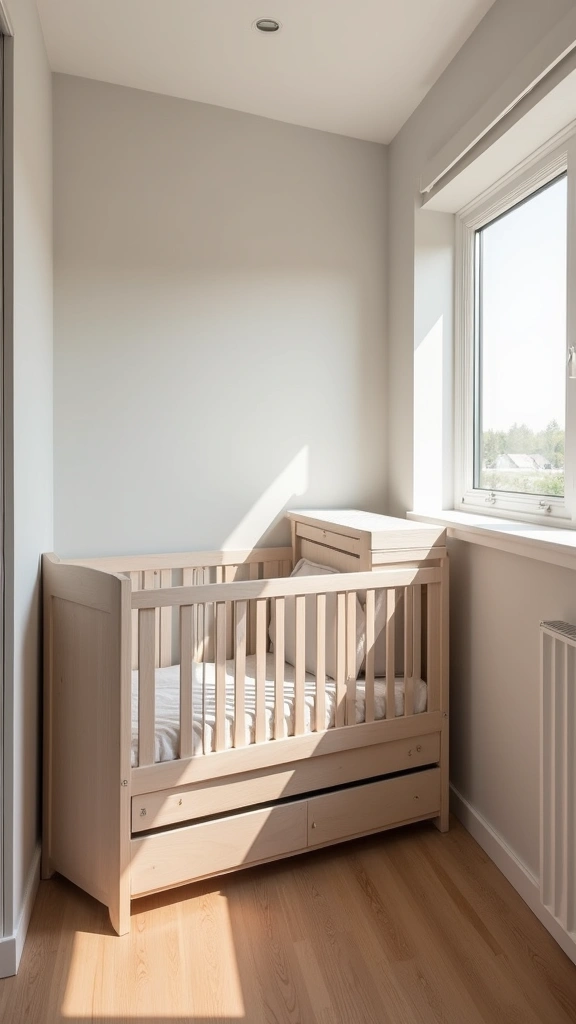
If your nursery is small, you need smart furniture. A crib that doubles as a changing table saves floor space and cuts clutter. Here is why it helps and how to pick the right one for you.
– Built-in storage with drawers or shelves under the mattress keeps diapers, wipes, and outfits within reach.
– Adjustable height lets the crib grow with your child and saves your back during late night changes.
– Changing surface option A top changer or side changing area gives you a clean, safe spot for every diaper.
– Safe, non-toxic materials Look for solid wood or sturdy composites with a smooth, non-toxic finish and rounded edges.
– DIY dresser conversion If you want to save money, place a changing pad on a sturdy dresser and anchor it to the wall.
– Safety basics Stay with baby during every change; keep wipes, cream, and a spare diaper nearby; never leave the child unattended.
– Space fit tips Measure your room and doorways before buying; pick a model that fits through the door and into the corner you plan.
Next steps: look for models with these features at stores or online.
1. Opt for a Crib That Doubles as a Changing Table
Editor’s Choice
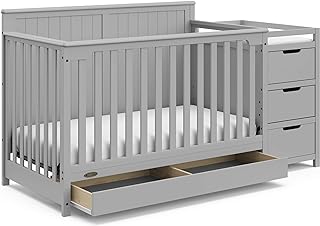
Graco Hadley All-in-One Convertible Crib & Changer (Pebble Gray) – GREEN…
 Amazon$339.99
Amazon$339.99
Munchkin Secure Grip Baby Diaper Changing Pad with Cover for Dresser, Wa…
 Amazon$27.29
Amazon$27.29
DECOMOMO Storage Bins, Cube Storage Bin with Labels, Fabric Storage Cube…
 Amazon$23.99
Amazon$23.992. Utilize Vertical Space with Wall Shelves
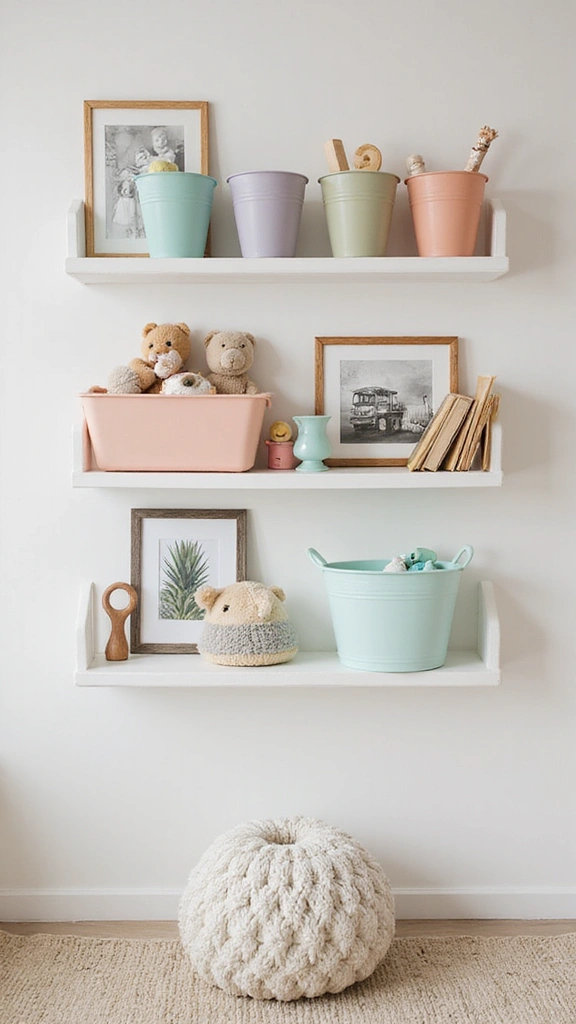
2. Use Vertical Wall Shelves to Free Floor Space
Here is why you need to think up, not out. When floor space is tight, you can still store and show baby things with wall shelves. They keep books, toys, and decor within reach while leaving the floor open for movement.
Next steps:
– Pick open shelves for quick access and a cozy look. Easy to grab a book, a pacifier toy, or a tiny lamp without bending down.
– Add color with bins or baskets. Put small items in bright containers so little hands can find them fast.
– Place floating shelves above the crib or changing table. It adds a soft, whimsical touch and keeps essentials handy.
– Always anchor shelves to studs or wall anchors. Safety first to avoid a topple.
– Create a mini gallery on the same wall. Frame simple art or photos to give the room a personal touch.
– Keep the setup tidy. Swap out items as baby grows and needs change.
This approach gives you real storage without crowding the room. It also lets you add personality through color, art, and playful decor.
2. Utilize Vertical Space with Wall Shelves
Editor’s Choice

AMADA HOMEFURNISHING Floating Shelves, Wall Shelves for Bathroom/Living …
 Amazon$19.98
Amazon$19.98
8 Pack Colorful Storage Bins with Lids Stackable Storage Container for O…
 Amazon$29.99
Amazon$29.99
Furniture Anchors (10 Packs) Anti Tip Furniture Anchors for Baby Proofin…
 Amazon$8.99
Amazon$8.993. Find an Ottoman That Opens for Storage
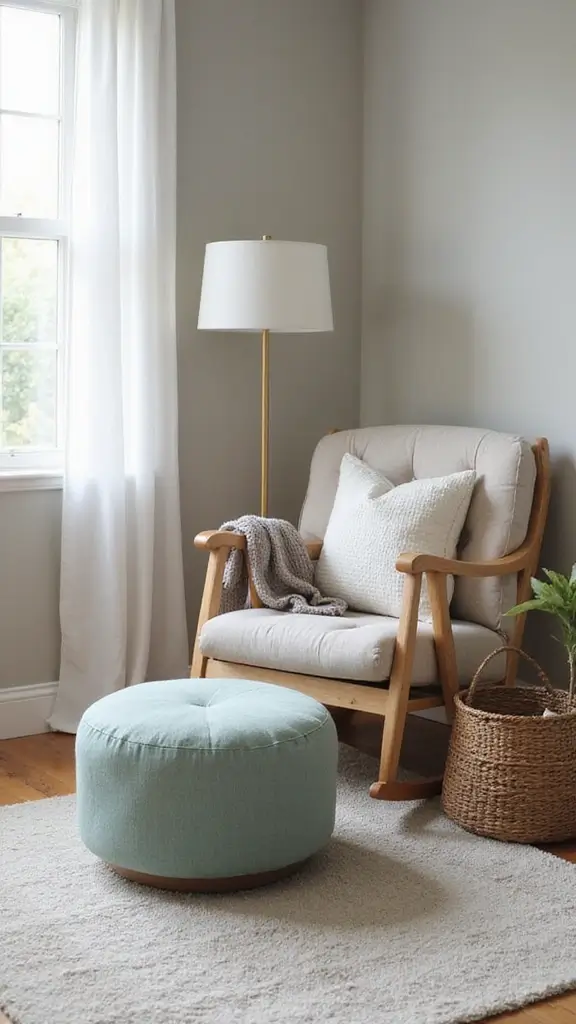
Why a storage ottoman helps in small nurseries
If your nursery is small, a storage ottoman can save space. It hides blankets, toys, and outfits in one soft lid. It frees floor space and cuts clutter. It also serves as a quick seat when you need a rest.
How to choose a storage ottoman
Choose a storage ottoman with safe opening. Look for soft-close hinges and a sturdy base. Pick a size that fits your room and crib. If you have kids, a cushioned top adds comfort for seating.
Fabric and color options
Fabric matters. Try microfiber or cotton blends. A faux-leather cover is easy to wipe. Pick colors that echo your theme. A solid hue stays calm, while a light pattern adds character. A soft-top helps as a footrest.
Placement and daily use
Place the ottoman at the foot of the crib or beside your chair. It gives a handy spot for nursing or cuddling. Use it as a footrest, a small toy stash, or a blanket hideaway. Keep the lid closed to stay tidy.
Practical steps to select
Measure your space first. Check that the interior storage fits your usual baby items. Read reviews on lid safety and durability. Choose a model that blends with your furniture for a calm, cohesive nursery.
Next steps
– Measure your space and list must-haves
– Compare 3-4 storage ottomans
– Pick a color that fits your theme
3. Find an Ottoman That Opens for Storage
Editor’s Choice

43″ Folding Storage Ottoman Bench for Living Room, Bedroom, TV Entertain…
 Amazon$30.95
Amazon$30.95
Velvet Storage Bench Ottoman with Soft Close Lid, End of Bed Bench Uphol…
 Amazon$129.99
Amazon$129.99
HomePop Square Tufted Storage Ottoman – Distressed Brown Faux Leather Small
 Amazon$62.99
Amazon$62.994. Choose a Compact Glider or Rocking Chair
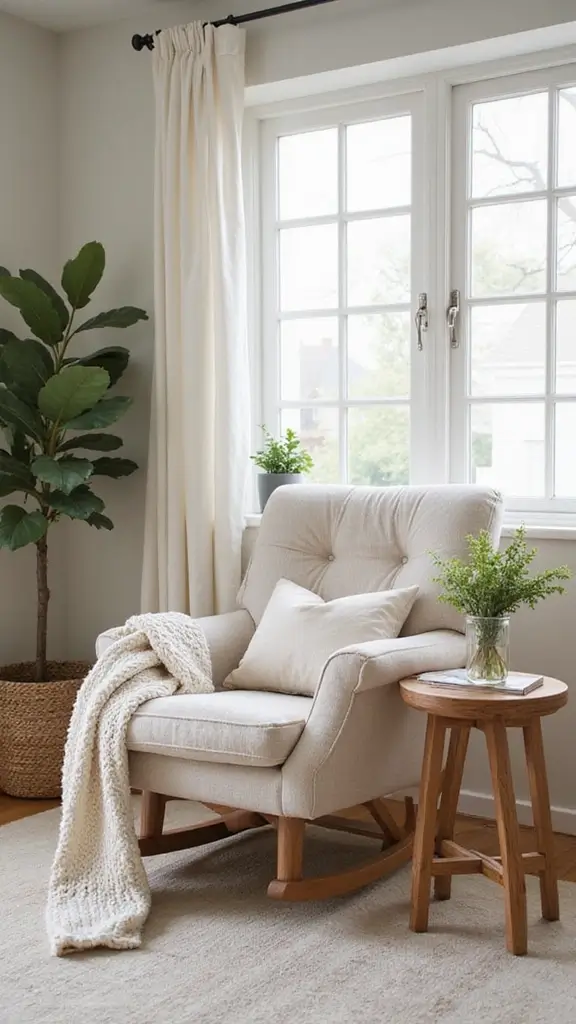
Is your nursery tight? You still need a comfy spot to feed and soothe. A big chair can crowd the room. The fix is a compact glider or rocking chair that fits your space and feels welcoming.
– Size that fits
Measure the space, doorways, and hallways. Check the chair depth and width so it can be moved easily.
– Comfort
Choose cushions with soft yet supportive fill. Test the glide and seat height so your feet rest flat.
– Storage
Look for pockets or a small pouch for books, burp cloths, and remotes. Storage keeps essentials in reach.
– Move with ease
Pick a lighter frame or add smooth glides. A chair that shifts quietly makes late feeds calmer.
– Clean and durable
Select stain resistant fabric or leather. Wipe clean and keep the base sturdy for daily use.
– Side table
Pair with a small table for water, a book, and wipes. It finishes the little feeding corner.
– Style
Choose a finish and color that match your nursery vibe. A simple silhouette fits most schemes.
– Setup tips
Place the chair in a quiet corner near the crib. Add a warm lamp and a small basket for wipes.
Next steps: test sit for a few minutes, check movement, and measure again before buying.
4. Choose a Compact Glider or Rocking Chair
Editor’s Choice

Yaheetech 360° Swivel Glider Chair for Nursery, Rocking Chair Nursing Ch…
 Amazon$149.99
Amazon$149.99
Costzon Glider and Ottoman Set, Wood Glider Rocker for Nursery, Upholste…
 Amazon$205.99
Amazon$205.99
3-Tier Small Narrow Wood Side Table with Charging Station, Skinny Nights…
 Amazon$25.48
Amazon$25.485. Use Baskets for Easy Organization
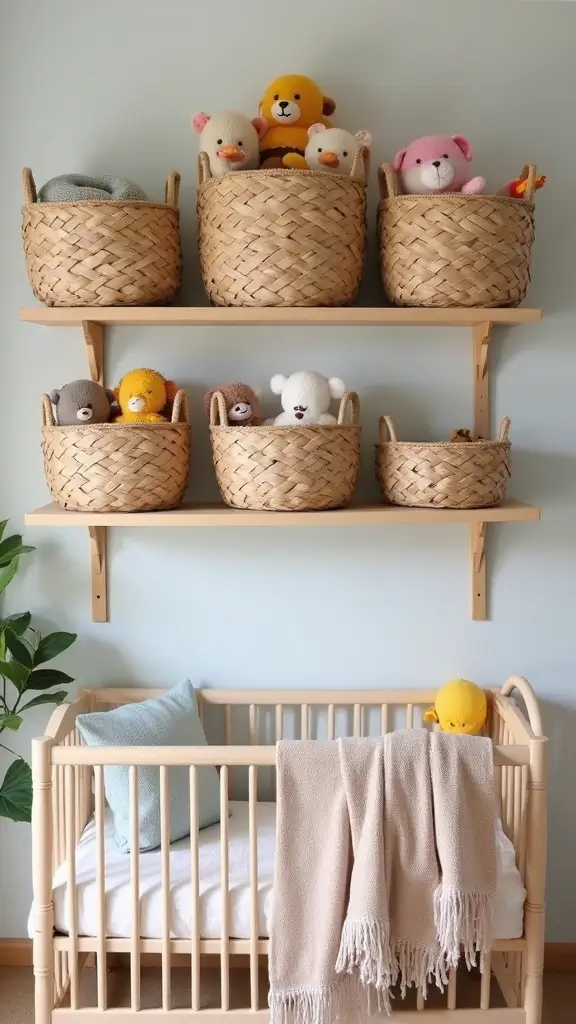
If your small nursery feels chaotic, baskets can restore order fast. They hide clutter and add soft texture to the space. With the right setup, you can reach for what you need in seconds.
– Mix sizes and textures. Use a large basket for blankets, a mid‑size one for diapers, and small bins for toys. Wicker, fabric, jute, and cotton baskets each show a different look.
– Put baskets where you actually need them. Shelves keep your goals visible. A basket under the crib is handy for quick diaper changes. In the closet, stack bins for outfits and sheets.
– Color them to pop. Pick colors that stand out against a neutral wall. A few bright tones can lift a calm room without overwhelming it.
– Label for fast cleanup. Simple tags or chalkboard labels tell you where things belong. You can color‑code by item type to speed up tidy time.
– Keep it safe and simple. Choose sturdy baskets with smooth edges. Make sure they stay away from heat or open flames and clear of the crib legs.
– Tip: When you see mess, grab a basket and group items in one place. That makes tidying quick when guests drop by or you need a fast reset.
Next steps: decide on two baskets for the day and three for the closet. Add a couple more as your space grows.
5. Use Baskets for Easy Organization
Editor’s Choice

StorageWorks Wicker Basket, Baskets for Organizing, Storage Basket with …
 Amazon$44.99
Amazon$44.99
Amazon Basics Collapsible Fabric Storage Cubes Organizer with Handles, S…
 Amazon$17.19
Amazon$17.19
Mr. Pen- Basket Labels Clip On Set, 32 pcs, 30 Removable Bin Labels Clip…
 Amazon$9.85
Amazon$9.856. Hang a Pegboard for Versatile Storage
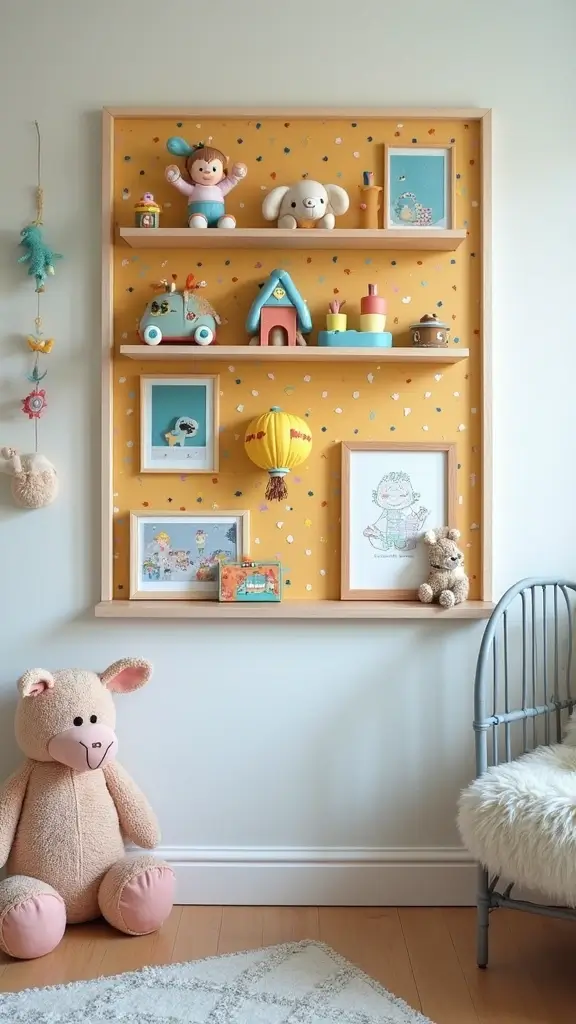
Here is why a pegboard makes sense in a small nursery. You gain vertical storage that stays visible and easy to grab. A pegboard holds soft toys, tiny books, picture frames, and art. You can swap items as your baby grows.
Next steps: pick a spot on a sturdy wall. Use studs or a brick wall. Mount a pegboard panel with proper screws. Paint it in a soft pastel that fits your theme, like blush pink, mint, or pale gray. It stays quiet and calm in the room.
What you can hang and store:
– Hang soft toys on round hooks to keep them neat.
– Use small shelves for board books.
– Clip decorative items like frames and photos.
– Clip baskets or bins to pegs for tiny clothing or mittens
Tips to keep it safe and neat:
– Keep cords and small parts away from little hands.
– Check fasteners every few months.
– Use 1–2 sturdy shelves or trays, not a wall full of clutter.
Growth as your baby grows:
– Swap decor as moods change.
– Move items higher as your baby learns to crawl.
This pegboard setup helps a small nursery stay tidy. It blends storage and display while guiding your room’s theme.
6. Hang a Pegboard for Versatile Storage
Editor’s Choice

FZK Peg Board,36pcs Pegboard Kit, Includes 4 White Pegboard and Accessor…
 Amazon$35.99
Amazon$35.99
OIAHOMY Large Blanket Basket, 22”x17”x12” Rectangle Woven Baskets, Nurse…
 Amazon$21.59
Amazon$21.59
Bikoney Picture Frames Collage Photo Hanging Display Picture Board Wood …
 Amazon$12.59
Amazon$12.597. Create a Play Area with Foldable Mats
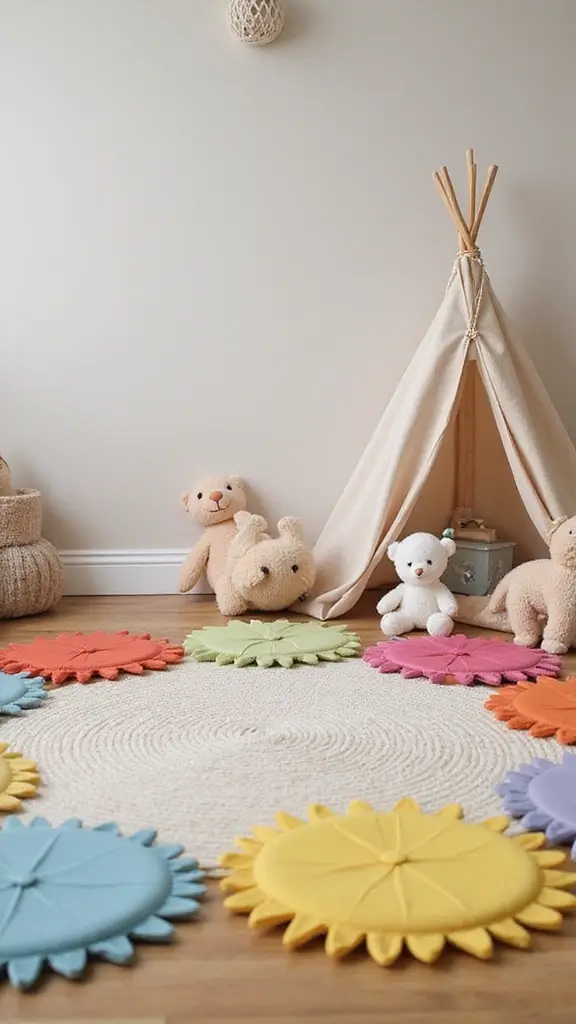
Small rooms need a safe play zone you can manage. Foldable mats give you that. They cushion the floor and tuck away when playtime ends.
Here is what to look for in a mat you can fold or roll:
– Non-toxic foam that wipes clean and stays smooth.
– A thickness of about half to one inch for good cushion.
– A finish that resists stains and tears.
– Easy fold or roll for fast storage.
– Bright colors or playful patterns to spark curiosity.
– A size that fits your corner without blocking the door.
Set it up in a smart spot:
– Pick a corner near the crib or a wall to keep edges safe.
– Lay the mat flat for play, then roll or fold it away after.
– Add a small bin or shelf nearby to store toys and books.
Storage and decor:
– Store the mat under the crib or in a closet when not in use.
– Choose colors that fit your nursery, so it blends with decor.
– When opened, it becomes a friendly play area for exploration.
Also pick a mat that cleans easily with a damp cloth.
Next steps: check for wear, wipe it clean, and swap as your baby grows.
7. Create a Play Area with Foldable Mats
Editor’s Choice

Baby Play Mat, 50 x 50 Inch Play Mat Perfect for Use Baby Playpen, Folda…
 Amazon$23.74
Amazon$23.74
Baby Play Mat, 50 x 50 Inch Play Mat Perfect for Use Baby Playpen, Folda…
 Amazon$23.74
Amazon$23.74
Baby Play Mat, 50 x 50 Inch Play Mat Perfect for Use Baby Playpen, Folda…
 Amazon$23.74
Amazon$23.748. Minimize Furniture with a Changing Basket
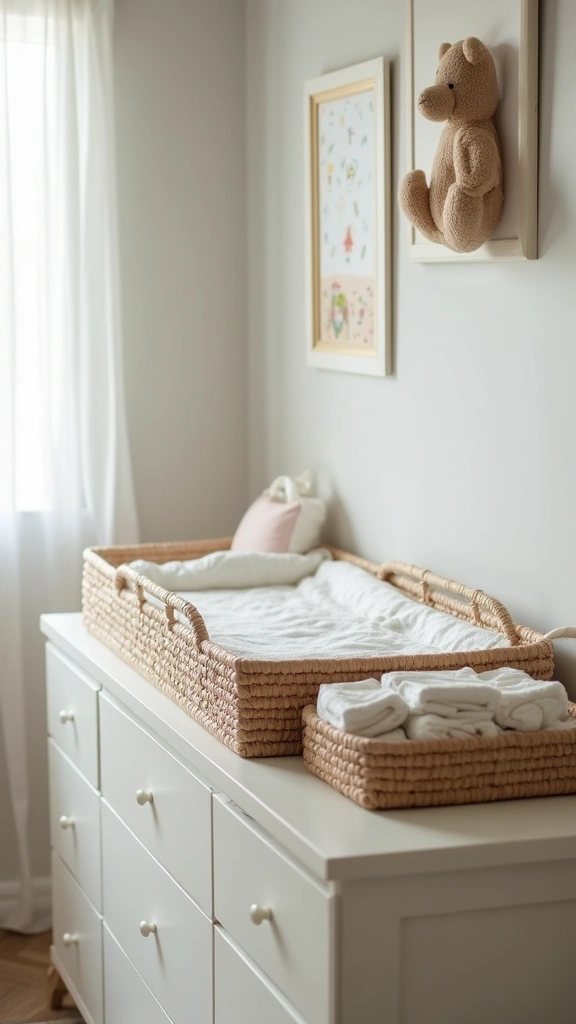
If you want a calm, open nursery in a small space, a changing basket can help more than a bulky table. You gain floor space and easy moves. You still have a ready spot for diaper changes.
Here is why it works: the basket is light and portable. You can carry it from the nursery to another room for late-night changes. A soft changing mat fits inside for comfort. Put a simple liner inside to keep items tidy.
Next steps for setup:
– Choose a woven or canvas basket with sturdy handles.
– Add a thin, washable changing mat inside.
– Stock wipes, diapers, diaper cream, and a spare outfit in small pockets or pouches.
– Place the basket on a dresser top for quick reach, or set it on the floor with the mat ready.
– Keep a few essentials in reach so you can change with one hand.
When baby grows, repurpose the basket. It makes a toy bin, book holder, or laundry tote. The system stays light, clean, and adaptable in a tiny room.
Safety reminder: never leave your baby alone on any surface. Always have one hand on your little one during a change.
This setup stays neat and helps you feel ready. Keeps things simple.
8. Minimize Furniture with a Changing Basket
Editor’s Choice

Baby Changing Basket – Moses Basket Bassinet & Changing Table Topper for…
 Amazon$84.90
Amazon$84.90
Diaper Changing Pad Liner Non-Slip, Waterproof Terry Mat, Quilted Absorb…
 Amazon$9.99
Amazon$9.99
Mr. Pen- Baby Diaper Caddy Organizer, Car Caddy, Portable Organizer for …
 Amazon$12.85
Amazon$12.859. Go for Foldable Cribs
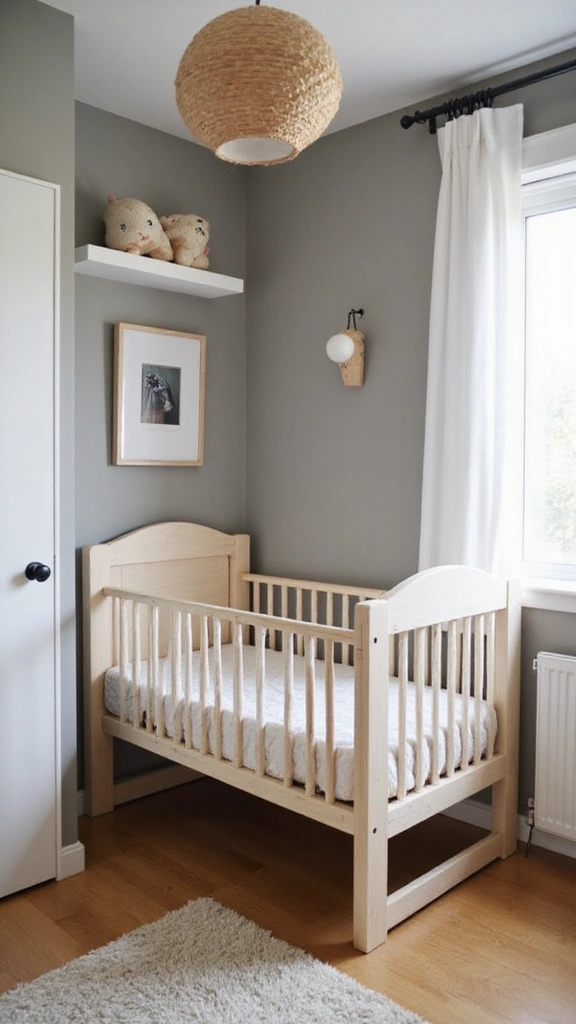
Small rooms need smart sleep. Foldable cribs fit the bill. They fold flat, so you can tuck them away. Some models roll on wheels for easy moves. Many models do double duty by turning into a playpen. This keeps a calm, roomy feel in your space overall.
Here is why foldable cribs work for you:
– Foldable design saves space and stays sturdy
– Wheels with locking brakes move it, then hold it steady
– Quick fold means setup in minutes, easily
– Some models convert to a playpen for extra use
strong>
Next steps to pick a good one:
– Check safety standards like JPMA or CPSC
– Confirm folded size is compact and the weight is very light
– Ensure the mattress fits snugly and the sides breathe
How to use it day to day:
– Place it near your bed at night, safely
– Use a fitted sheet and keep loose items out of sleep space
– Practice folding once a week so you can do it fast
Reality check:
– They may not feel as sturdy as a full crib, especially cheaper models
– Some foldables are heavy when folded
– They may wear out faster with daily use
– Change may come later if your child grows fast
9. Go for Foldable Cribs
Editor’s Choice

Delta Children Folding Portable Mini Baby Crib with 1.5-inch Mattress – …
 Amazon$138.66
Amazon$138.66
74″ ×50″ Large Baby Playpen, Baby Playard for Babies and Toddlers, Baby …
 Amazon$49.99
Amazon$49.9910. Utilize Door Space with Hooks
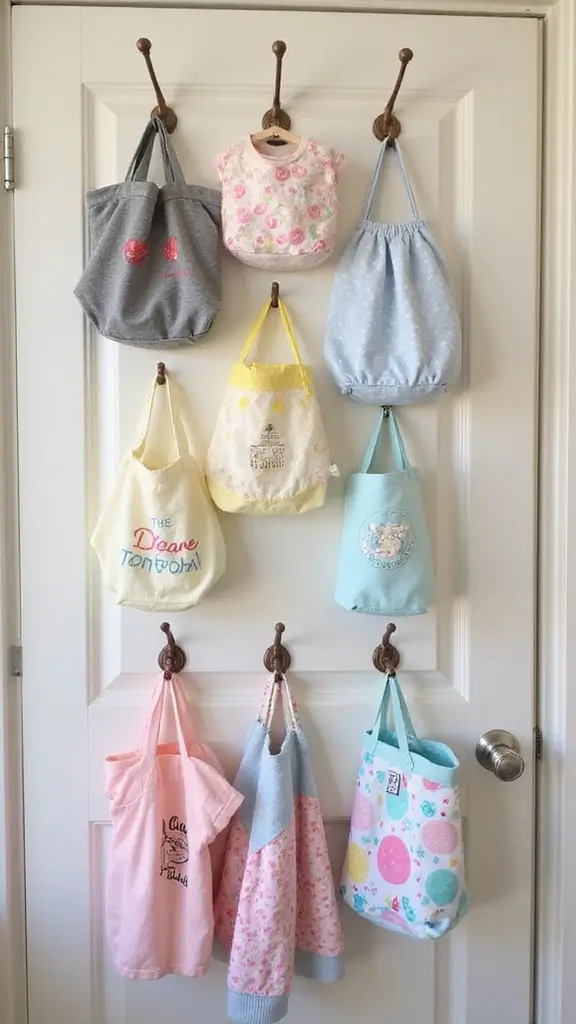
Small nurseries need smart storage. Doors hide a lot of space. Installing hooks on doors gives you extra spots for toys, outfits, or baby gear without adding clutter on the floor. You can grab items fast and keep the room calm.
What to hang
You can hang bags, hats, bibs, and small organizers with wipes or socks. This keeps essentials in reach for diaper changes. Decorative hooks add color or a touch of theme.
Choosing hooks
Choose hooks. Use over-the-door hooks for sturdy, simple use. For light items, adhesive hooks work. If you want, mount inside the door with small screws but watch the weight. Match metal, wood, or ceramic hooks to your style.
Simple setup
Steps:
1. Pick a few hooks that fit your door and style.
2. Measure door thickness and what you plan to hang.
3. Place hooks on the back or the side that is easy to reach. Avoid hinges.
4. Group items by use; for example, everyday burp cloths and pacifiers on one, extra outfits on another.
Tips
Keep doors open? Not necessary. Use soft bumpers to protect the door. Check weight. Reorganize after a week if items shift. Decor ideas: color-coded hooks can tie the room together. It costs little and works fast.
10. Utilize Door Space with Hooks
Editor’s Choice

FYY Over The Door Hooks, 4 Pack Hangers Hooks with Rubber Prevent Scratc…
 Amazon$5.98
Amazon$5.98
Adhesive Hooks Kitchen Wall Hooks – 24 Packs Heavy Duty 24lb(Max) Nail F…
 Amazon$6.98
Amazon$6.98
Railroad Spike Cast Iron Hooks (10 Pack) Handmade Blacksmith, Wall Mount…
 Amazon$19.95
Amazon$19.9511. Create a Reading Nook with Low Shelves
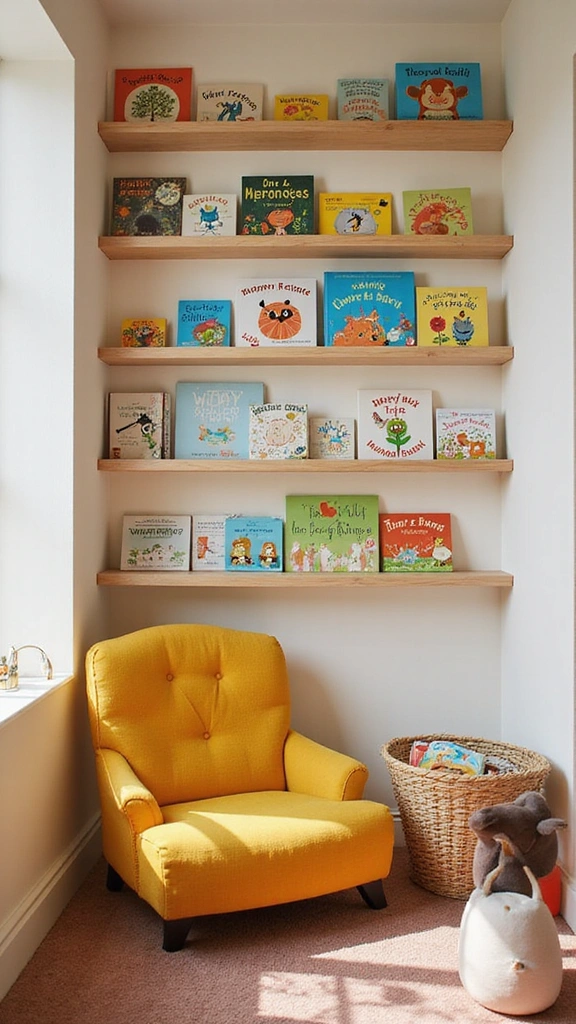
Your nursery is small, but you can still make a warm reading nook. You want a space that stays neat and inviting. Use low shelves within your child’s reach to spark a daily love of books.
– Find a quiet corner with soft light.
– Anchor low shelves to the wall so they won’t tip.
– Choose shelves at your child’s eye level.
– Pick sturdy shelves with rounded edges.
– Add a small seating option like a bean bag or floor cushion near the shelves.
– Place a soft rug to soften the floor and create a cozy space.
– Stock board books and sturdy picture books that little hands can explore on their own.
– Include a few soft stuffed animals for comfort and color.
– Use simple baskets to keep books upright and easy to scan.
– Rotate a few titles weekly to keep interest high.
– Choose a bright picture book with big images to grab attention.
– Keep the area easy to wipe clean with washable fabrics.
– Make shelf height reachable but not cluttered.
– Let your child help choose a few favorites to place on the shelves.
– Place a small lamp or night light to soften the mood.
With this setup, reading becomes a calm daily habit.
11. Create a Reading Nook with Low Shelves
Editor’s Choice

Meangood Floating Shelves Wall Mounted Set of 2, Rustic Wood Wall Storag…
 Amazon$21.84
Amazon$21.84
MeMoreCool Square Floor Pillow for Adults and Kids, Large Meditation Cus…
 Amazon$36.99
Amazon$36.99
Washable Area Rugs 5’x7′ Non-Slip Modern Abstract Soft for Living Room E…
 Amazon$39.99
Amazon$39.9912. Incorporate Multi-Use Furniture
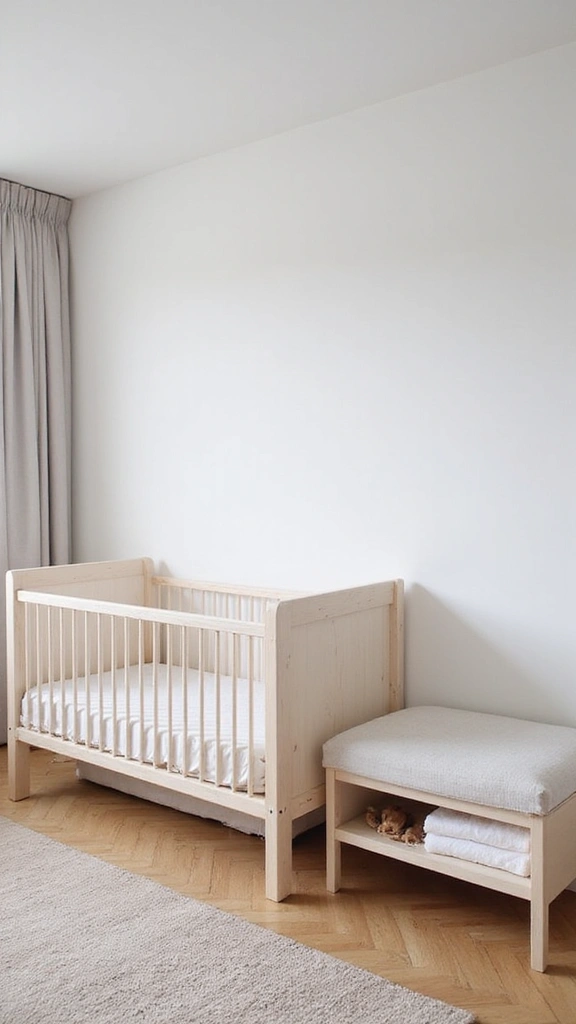
Here is why multi-use furniture shines in small nurseries. It frees floor space without making the room feel busy. You gain more surface area for feeding, reading, and play. You also cut down on buying new pieces as your child grows. Let us break it down with practical choices.
– Convertible crib that grows with your child Choose a crib that can become a toddler bed. It keeps the same look and saves you a new frame later. Look for smooth conversions and small hardware.
– Changing table that doubles as a dresser One piece serves two jobs. A wide top for changes, then a lower drawer setup for clothes. This cuts clutter and keeps essentials in reach.
– Storage bench with hidden space Sit down to dress and stash blankets or toys in the lid. It adds seating while hiding clutter.
– Wall-mounted shelves with bins Keep surfaces clear. Put daily items in colorful bins and label them for easy finding.
– Bed with built-in drawers Drawers under the bed hold sheets and seasonal clothing. No extra furniture, more usable space.
Next steps: measure, check safety, and pick finishes that suit your style and room color.
With these options, you keep the nursery calm and ready for growing needs. Take your time, and test each piece for safety and ease of cleaning.
12. Incorporate Multi-Use Furniture
Editor’s Choice

Graco Benton 5-in-1 Convertible Crib (White) – GREENGUARD Gold Certified…
 Amazon$169.99
Amazon$169.99
Changing Table Dresser, Baby Classic Nursery Dresser with 5 Drawers and …
 Amazon$199.99
Amazon$199.99
SONGMICS MAZIE Collection – 43 Inches Folding Storage Ottoman Bench, Ott…
 Amazon$39.99
Amazon$39.9913. Use Clear Containers for Easy Visibility
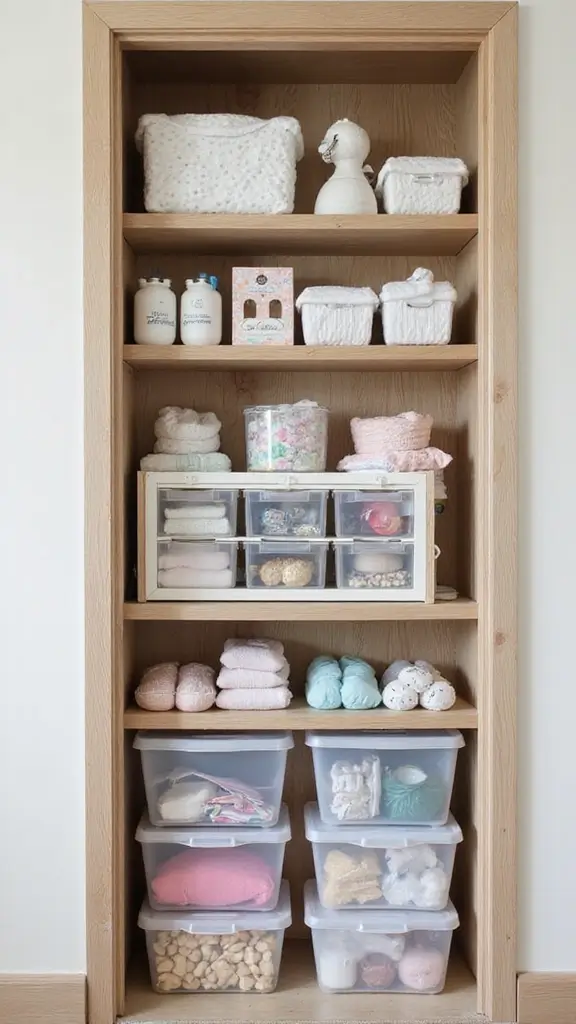
Clear containers for easy visibility in a small baby room
Small spaces fill up fast. When you cant see what you own, clutter grows. Clear containers help you spot toys, clothes, and feeding gear in seconds.
– Pick transparent, safe containers that are BPA-free and shatter-resistant.
– Select stackable bins with lids to protect items and save shelf space.
– Label each container with clear words or simple icons.
– Sort items by category, like toys, clothes, and feeding supplies.
– Keep frequently used items at eye level for quick access.
– Use shallow bins for small pieces and shelf dividers to stop tipping.
– Rotate toys and outfits every few weeks to stay organized.
– Stick to a calm color scheme to maintain a tidy look.
– Keep a small bin by the changing table for wipes and creams.
– Choose labels with words and pictures so caregivers know what to grab.
– Hide rarely used items in higher shelves to free up space.
– Select containers with smooth edges to protect curious hands.
With this system, your room stays neat and calm. You save time every day and your baby’s space feels ready for any moment.
13. Use Clear Containers for Easy Visibility
Editor’s Choice

IRIS USA 13 Qt Stackable Plastic Storage Bins with Lids, 6 Pack – BPA-Fr…
 Amazon$34.99
Amazon$34.99
DYMO Label Maker Machine with Tape – 100H LetraTag Handheld, Comes with …
 Amazon$43.89
Amazon$43.89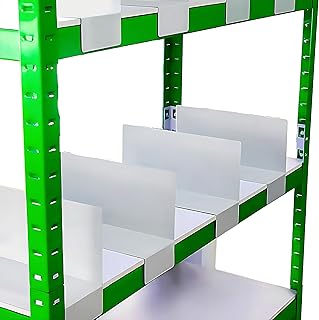
20 Pcs 30 * 12CM 1MM Separator Shelf Dividers Warehouse Shelf Isolation …
 Amazon$39.90
Amazon$39.9014. Hang Over-the-Crib Mobile Storage
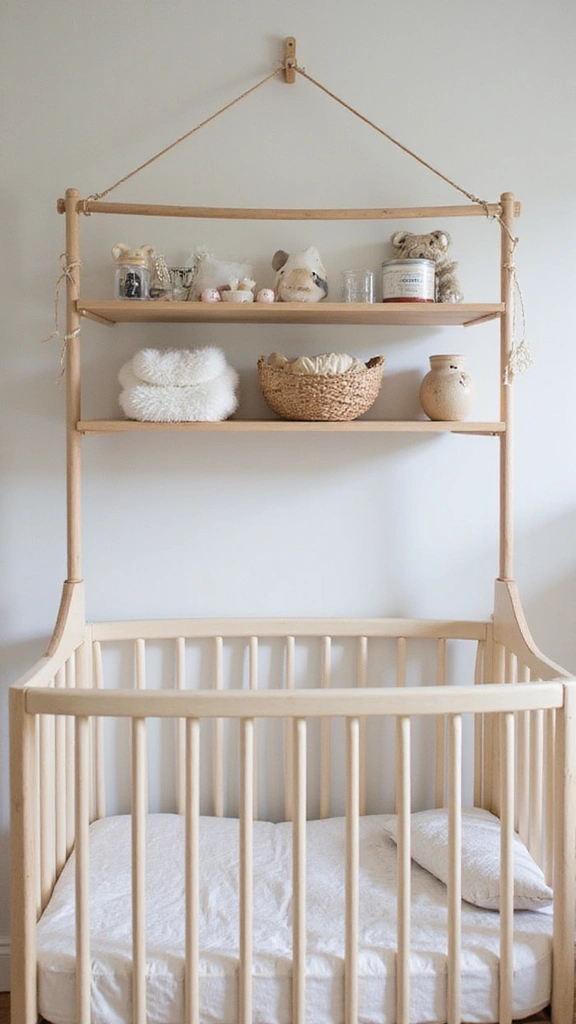
If your nursery is small, you need smart storage that doesn’t crowd the floor. Hang a storage unit over the crib and you gain quick access without losing space. This over-the-crib organizer keeps daily essentials within reach during diaper changes or late-night feeds.
What to look for:
– Lightweight fabric or wood tone that matches your decor.
– Clear pockets or labeled sections so you spot items fast.
– A sturdy mounting system that fits your crib rail or ceiling beam.
How to set it up:
– Measure your crib width and ceiling height.
– Choose a model with adjustable straps or a secure rail mount.
– Install with a strong hook or bracket.
– Tuck straps and cords away to avoid hazards.
What to store and why:
– Pacifiers, wipes, and a small night light.
– Extra blankets, burp cloths, and a few quiet toys.
– Diaper cream and small first-aid items for quick reach.
Style tips:
– Pick tones that match your crib sheet and rug.
– Consider a clean, minimalist look for a calm nursery.
Safety reminders:
– Check the mount monthly.
– Do not hang heavy items.
– Keep items above the baby’s reach and away from the face.
Next steps:
– Choose a simple model, set it up this weekend, and enjoy a tidier space.
14. Hang Over-the-Crib Mobile Storage
Editor’s Choice

Hanging Diaper Organizer for Crib/Playpen/Bassinet – Hold 80+ Diapers – …
 Amazon$22.99
Amazon$22.99
Amazon Basics Collapsible Fabric Storage Cubes Organizer with Handles, S…
 Amazon$15.98
Amazon$15.98
Upgrade 0.46’’ Big Hole Ceiling Hooks for Hanging Lights,Aluminum Ceilin…
 Amazon$15.90
Amazon$15.9015. Make Use of Closet Organizers
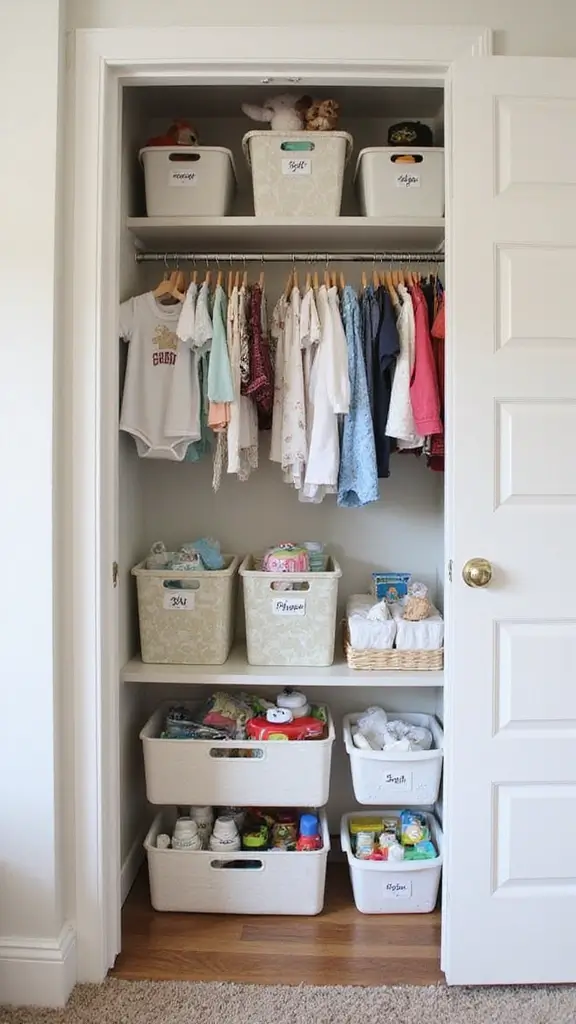
Is your baby closet a catchall? A few closet organizers can turn it into a clean, easy-to-use space. You will save time and keep the room tidy.
Here is how to set it up:
– Declutter and sort Empty the closet, group items into clothes, toys, and gear, and keep only what you actually use in the next few weeks.
– Pick the right organizers Use tiered organizers for folded outfits, hanging shelves for tiny clothes and blankets, and bins on the closet floor or shelves for toys and gear.
– Plan the layout Place daily wear at eye level on a short rod, put bigger items on the lower shelves, store seasonal gear up high, and keep small items in small bins.
– Label and maintain Stick simple labels on each bin or shelf, and do a quick weekly tidy to keep the system neat.
– Materials to consider Use sturdy shelves, fabric bins for soft items, and clear bins for quick finds, and mount rods firmly to avoid sag.
– Why it helps You spend less time searching and your simple design stays neat in a tight space.
– Next steps Try the setup for a week and tweak where needed.
15. Make Use of Closet Organizers
Editor’s Choice

Space Saving Clothes Hangers – 5-in-1 Shirt & Coat Hangers with Non-Slip…
 Amazon$19.99
Amazon$19.99
Amazon Basics Collapsible Fabric Storage Cube Bins Organizer with Handle…
 Amazon$18.99
Amazon$18.99
YIHONG 6 Pack Clear Pantry Organizer Bins, Plastic Containers with Handl…
 Amazon$22.09
Amazon$22.0916. Choose a Neutral Color Palette
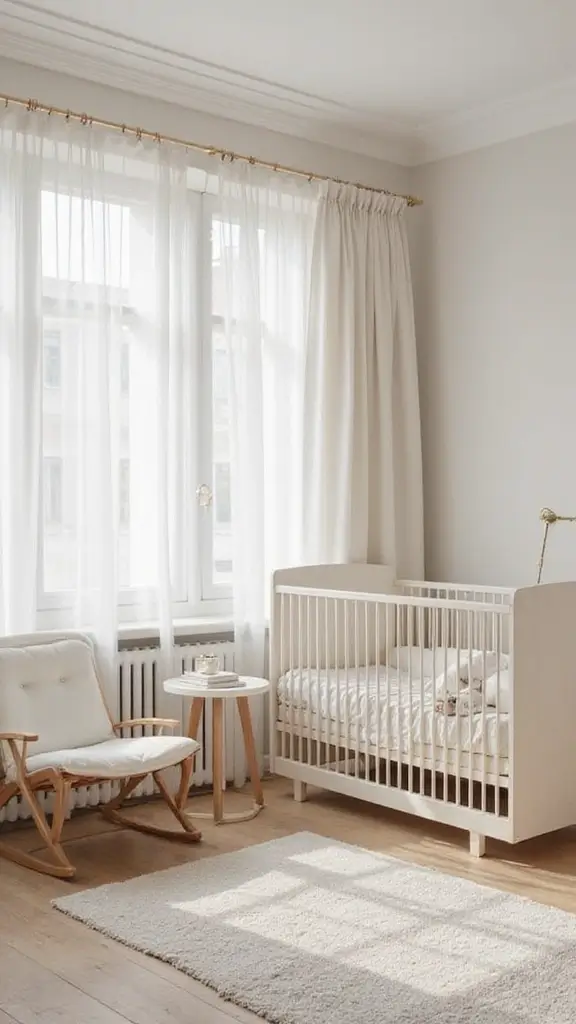
If you want a nursery that stays calm as your baby grows, a neutral color palette is your best bet. Soft whites, warm beiges, pale grays, and gentle pastels set a peaceful stage.
Here is why it helps: the room feels larger and brighter. It is easy to refresh with new fabrics or art without repainting. It also keeps the space calm for both you and your baby.
How to build it
– Paint base walls in a warm white or light gray.
– Choose washable paints and low-VOC options for a safer space.
– Pick furniture in light wood tones or crisp white.
– Keep hardware simple.
– Add a soft floor layer with a wool or cotton rug in a neutral shade.
Add pops of color with accessories
– Choose blankets, throws, or a rug in one or two accent colors.
– Hang art that uses those same tones.
– Use storage baskets in coordinating hues.
Let texture do the work
– Mix cotton, linen, and wool for depth and warmth.
– Choose materials that are easy to wash.
Next steps: test swatches in daylight and move pieces around until the balance feels right. When the baby grows, swap small textiles or art to keep the room fresh without a full redo.
16. Choose a Neutral Color Palette
Editor’s Choice

PRESTIGE Interior Paint and Primer in One, Country Moss, Semi-Gloss, 1 G…
 Amazon$54.61
Amazon$54.61
8×10 Washable Neutral Area Rug Beige Floral Living Room Bedroom Large Ca…
 Amazon$109.99
Amazon$109.99
Mkono Woven Storage Basket Decorative Natural Rope Basket Wooden Bead De…
 Amazon$24.99
Amazon$24.9917. Install a Curtain to Separate Spaces
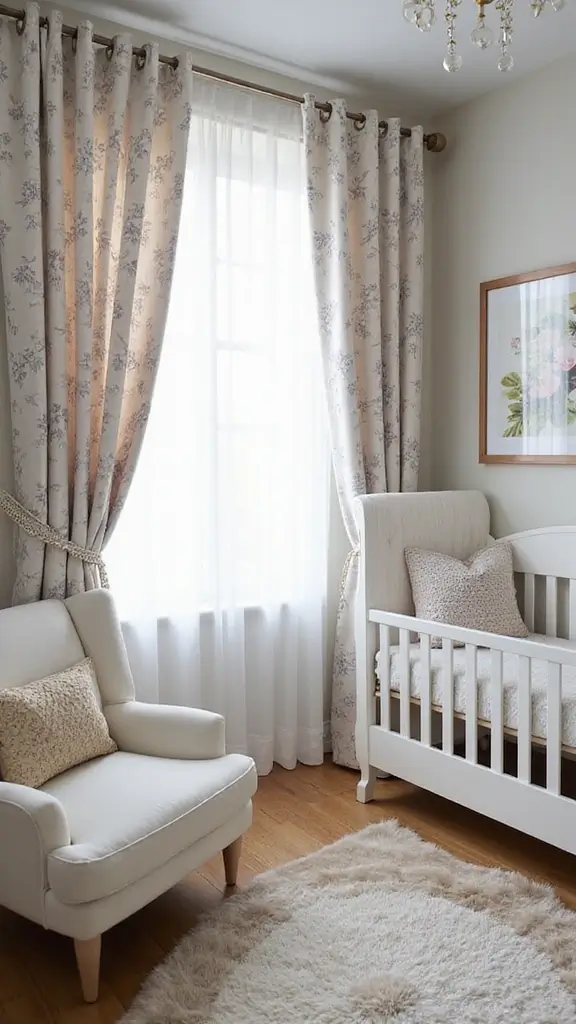
If your nursery shares space, a curtain can carve out a cozy nook for your baby. It adds privacy and a soft boundary without splitting the room. Nap times feel calmer when the space has its own mood. If you want more privacy, pair the curtain with a slim shelf to screen the view.
Why a curtain helps
It acts as a simple divider. It softens light and creates a quiet corner. You can open it in the day and close it for naps.
Fabric choices
– Light-filtering cotton or linen lets in soft light and keeps things gentle.
– Sheer fabrics add a dreamy, airy feel while blocking glare.
– Pick fabrics that wash easily and dry fast.
How to install
– Use a light curtain rod or a tension rod across the doorway or in the corner.
– Hang the curtain so it falls near the floor but won’t touch the crib.
– Leave a small gap for air and easy access.
– This helps keep cords out of the way and makes setup simple.
Style ideas
– Match colors to your nursery, like soft gray with white stars or pale mint with cream.
– Add a tiny pattern or border to reinforce the theme.
– Keep it simple by day and let a playful touch show during playtime.
Care and safety
– Wash regularly; follow the label and trim loose threads.
– Keep cords out of reach and pick cordless options.
– This simple curtain helps the space feel calm and cozy for every nap.
17. Install a Curtain to Separate Spaces
Editor’s Choice

MIULEE Natural White Linen Curtains 84 Inch Long for Bedroom Living Room…
 Amazon$18.95
Amazon$18.95
Black Shower Curtain Rod 31 to 80 Inch,1 Inch Diameter Adjustable Spring…
 Amazon$15.99
Amazon$15.99
Meangood Floating Shelves Wall Mounted Set of 2, Rustic Wood Wall Storag…
 Amazon$21.84
Amazon$21.8418. Incorporate Mirrors for Light and Space
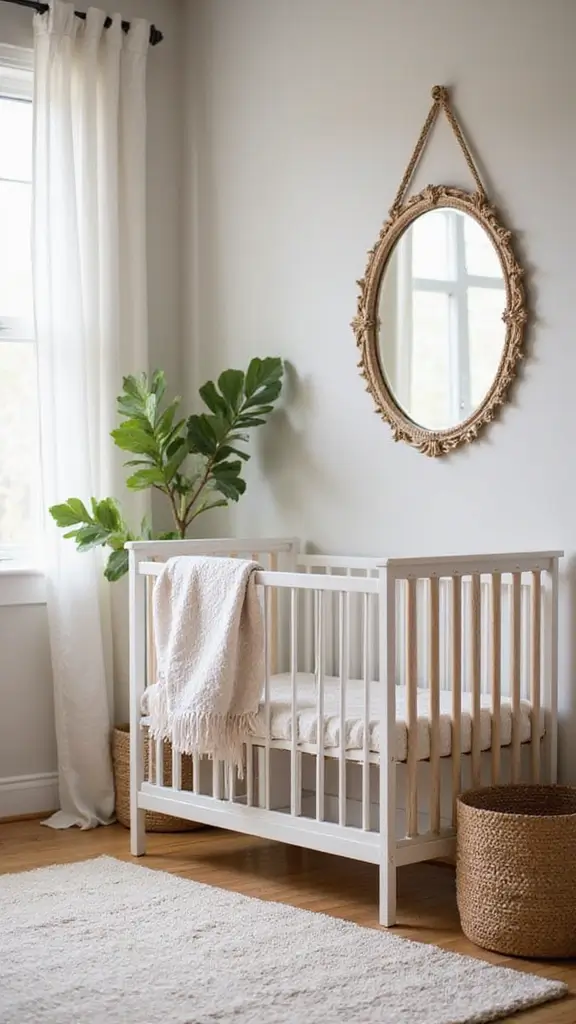
Struggling with a tiny nursery that feels closed in? Here is why mirrors can help. They bounce light from windows and lamps, making the room feel wider and more awake. A well placed mirror can push the eye deeper into the space, so you notice more air and less crowding. You can choose a mirror that fits your style while keeping safety in mind.
– Go big for a bright effect A large, decorative mirror spreads light across the room and creates an open feel. Pick a frame that echoes the crib or dresser so it looks like part of the decor, not an afterthought.
– Mount above the dresser or changing table Secure it high on the wall so tiny hands can’t grab it. This spot helps light sweep through the room as you change and dress, making late nights feel kinder.
– Create a mini mirror gallery Mix several small mirrors in a playful layout. Round and square shapes, light frames, and a quirky arrangement become art that also makes the space feel bigger.
– Choose mirrored doors or tiles Sliding mirrored closet doors reflect light all over. If you can’t swap doors, try stick on mirror tiles to brighten a wall without a big renovation.
– Smart placement tips Aim a mirror to reflect a window for daylight or a lamp for evening glow. Always anchor mirrors to walls and keep them high enough to stay safe.
Next steps: start with one sturdy mirror and test how light travels through your room. You’ll notice the difference quickly.
18. Incorporate Mirrors for Light and Space
Editor’s Choice

Full Length Mirror, 28″x 55″ Window Pane Decorative Mirror for Wall, Bla…
 Amazon$109.99
Amazon$109.99
Unbreakable Mirror Tiles, 4PCS 10”x10” Peel And Stick on Mirror for Wall…
 Amazon$9.49
Amazon$9.49
Black Round Mirror, Round Mirror 24 inch, Black Circle Mirrors Metal Fra…
 Amazon$39.99
Amazon$39.9919. Use Decorative Ladders for Additional Storage
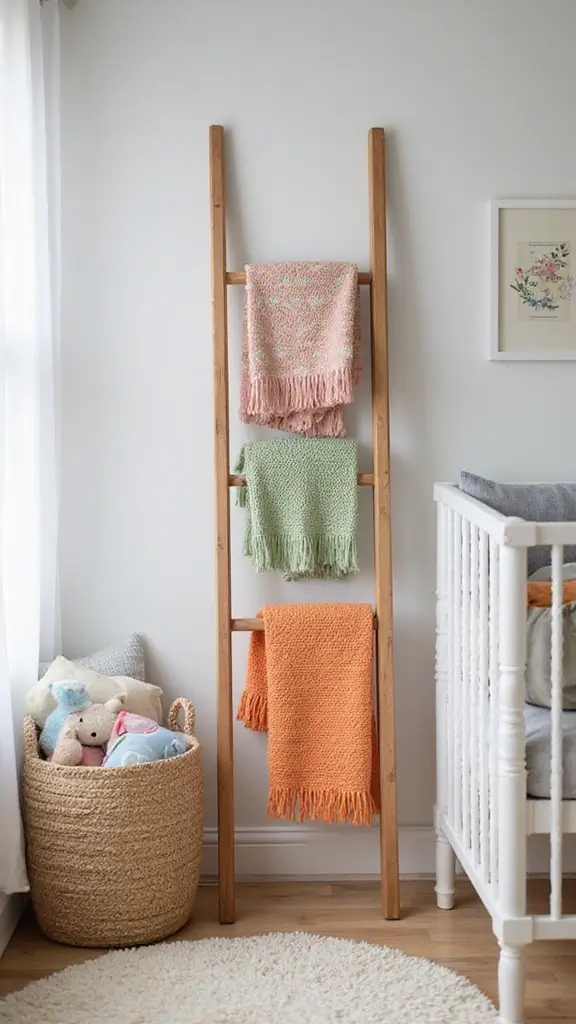
A decorative ladder can save space in a small baby room. It gives you storage without crowding the floor. Lean it to a wall or choose a slim metal ladder that fits tight spaces.
– Choose the right ladder. Pick a slim design that fits your room. Wood adds warmth; metal looks clean. It should be sturdy and easy to move if you need to adjust.
– Where to place. Put it near the changing area or beside the crib. You can lean it or mount it with brackets. Keep it away from busy play zones for safety.
– What to hang. Hang lightweight blankets, swaddles, hats, and small outfits. Use clips or hooks to keep items secure. Drape a colorful throw over a rung for a quick pop of color.
– Styling tips. Match the ladder to your furniture or choose a soft contrast. Pastels feel calm; bright accents add flair. Let the ladder show your style without overdoing it.
– Safety tips. Keep items light. Do not overfill. Check for wobble regularly. Move the ladder away from little hands when they crawl.
– Maintenance. Rotate items seasonally. Fold and store pieces so the space stays neat.
Next steps: measure your wall, pick a ladder, and test it with a few items. You gain extra storage and a personal touch in minutes.
19. Use Decorative Ladders for Additional Storage
Editor’s Choice

WOA WOA 3 Step Ladder, Foldable Step Stool, Aluminum Lightweight Ladder …
 Amazon$69.90
Amazon$69.90
FRESH IDEAS Comforter Clips for Duvet Covers, Helps Prevent Blanket from…
 Amazon$9.99
Amazon$9.99
BATTILO HOME Multicolor Throw Blanket for Couch, Colorful Afghan Throw B…
 Amazon$32.99
Amazon$32.9920. Personalize with Art and Photos
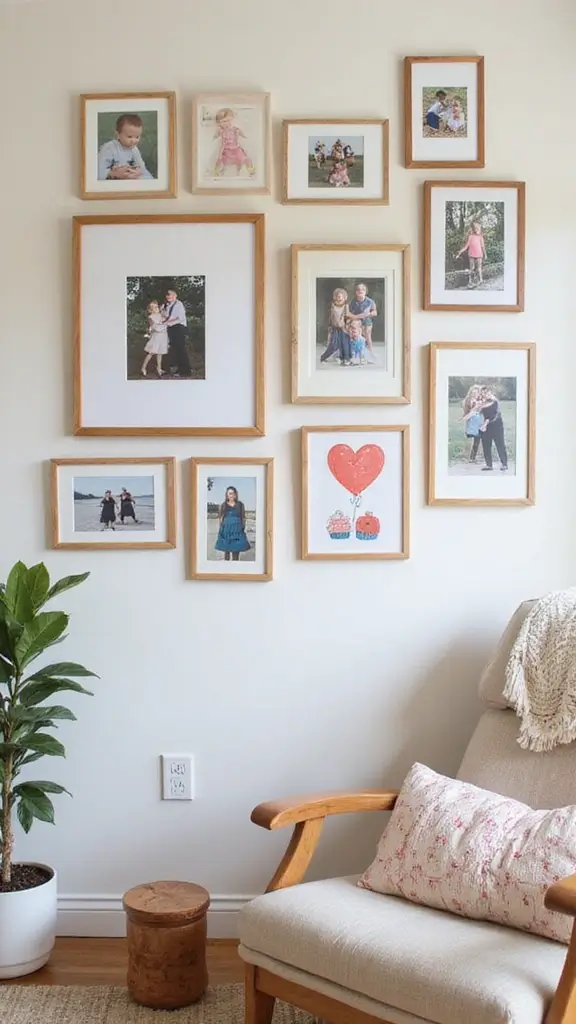
You want a warm nursery that fits a small space. Personal touches can make any room feel homey. Art and photos bring warmth and story to your baby’s room. Pick framed pieces you love, such as family portraits, your favorite quotes, or your baby’s first drawings. Use a consistent color tone to keep the wall calm, then add a pop of color with a few frames.
Here is why a gallery wall works in small spaces. It adds character without crowding the floor. A tight grid feels neat. A mixed setup adds charm and life.
What to include:
– Family photos in simple frames
– Your baby’s first art or doodles
– Short quotes or words that comfort you
Layout ideas:
A clean grid on one wall gives order. Try a vertical line on a narrow side. Slim shelves also help you rotate art without extra nails.
Safety first:
Hanging frames high keeps your child from reaching them. Use strong hooks or picture hanging strips rated for weight. Choose frames with sturdy glass or protectors. Keep cords and small pieces away from the wall area.
Next steps:
– Gather frames, pick photos and art.
– Lay out the design on the floor.
– Mark the wall, then hang with care.
– Rotate art every few months to refresh the space.
20. Personalize with Art and Photos
Editor’s Choice

eletecpro 12×12 Picture Frames Set of 9 Classic Gallery Wall Frame Set D…
 Amazon$37.99
Amazon$37.99
Command 15 lb Large Picture Hanging Strips 14 Pairs (28 Command Strips),…
 Amazon$9.57
Amazon$9.57
SONGMICS Floating Shelves, Set of 3 Wall Shelves, 15-Inch Wide, for Phot…
 Amazon$26.99
Amazon$26.9921. Embrace the Minimalist Trend
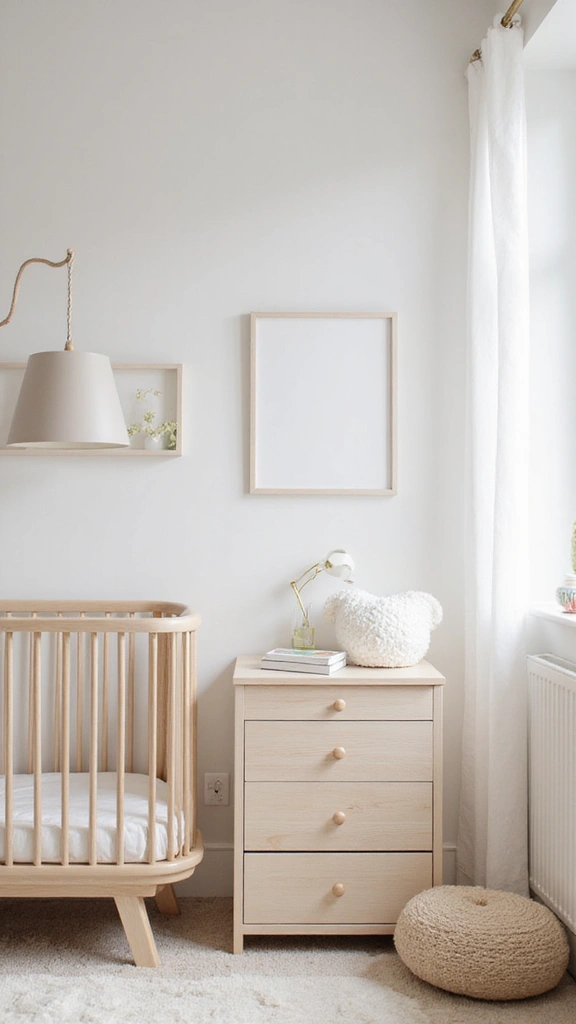
You want a baby room that feels calm yet fits a small space. A clean, simple setup helps you keep focus on what truly matters.
Here is why minimal design works: it cuts clutter, lowers stress, and makes daily routines smoother. Start by choosing only items that serve a real purpose. A crib with built-in drawers, a changing station that doubles as a dresser, and a slim book shelf save floor space.
– Keep a cohesive color plan. Go with two or three soft hues like ivory, pale gray, and gentle blush. It makes the room feel bigger and easier on the eyes.
– Use vertical storage. Wall shelves, hanging organizers, and closed bins save space while keeping toys and clothes out of sight but easy to reach.
– Pick quality pieces that last. Good construction matters in a small room where every item is in view.
– Let light in. Sheer curtains and a soft lamp create a gentle glow for naps and night feeds.
– Limit decor. A couple of framed prints or a wall mobile is enough to add charm without crowding.
Finish with a quick daily reset: smooth the changing area, tuck blankets away, and wipe surfaces. A tidy, minimalist nursery supports peaceful sleep and easier care.
If you need to upgrade later, swap out small decor for larger, longer-lasting pieces. A calm space helps you both sleep better and enjoy quiet mornings with baby.
21. Embrace the Minimalist Trend
Editor’s Choice

Graco Hadley 5-in-1 Convertible Crib with Drawer (White) – GREENGUARD Go…
 Amazon$254.99
Amazon$254.99
Graco Noah 3 Drawer Changing Table Dresser (Driftwood) – GREENGUARD Gold…
 Amazon$199.99
Amazon$199.99
Fixwal Nursery Shelves, 16.5 Inch Floating Bookshelves for Wall Set of 3…
 Amazon$23.99
Amazon$23.99Conclusion
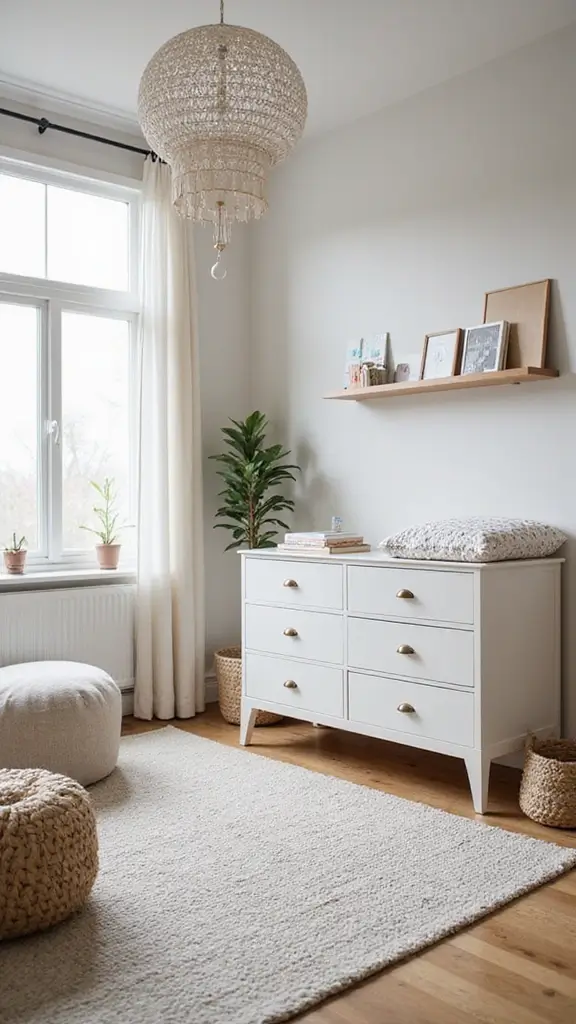
Designing a baby room in a small space can be both functional and stylish with the right hacks.
From multifunctional furniture to clever storage solutions, every tip shared can help create a cozy sanctuary for your little one.
As you embark on this exciting journey, remember that a minimalist approach can lead to a beautifully designed nursery that is perfect for both you and your baby.
Note: We aim to provide accurate product links, but some may occasionally expire or become unavailable. If this happens, please search directly on Amazon for the product or a suitable alternative.
This post contains Amazon affiliate links, meaning I may earn a small commission if you purchase through my links, at no extra cost to you.
Frequently Asked Questions
What are some essential baby room design hacks for small spaces?
Designing a baby room in a small space can be both functional and stylish! Start by incorporating multifunctional furniture like cribs that double as changing tables, which save valuable floor space. Additionally, using vertical wall shelves can help free up room while displaying adorable baby items.
Don’t forget to utilize creative storage solutions like storage ottomans and baskets to keep everything organized and clutter-free!
How can I maximize storage in my small baby room?
Maximizing storage in a small baby room can be a breeze with the right strategies! Utilize door space by installing hooks for hanging items, and consider adding pegboards to display toys and books.
Invest in clear containers for easy visibility of baby essentials, and make use of closet organizers to keep everything tidy. Remember, the goal is to keep your space functional yet stylish!
What types of furniture work best for a minimalist baby room?
In a minimalist baby room, opt for multi-use furniture that serves more than one purpose. For example, a compact glider can provide comfort without crowding the space, and a foldable crib can be stored away when not in use.
Look for pieces that are sleek and simple, allowing you to maintain a clean aesthetic while still providing the functionality you need for your little one.
How can I create a calming atmosphere in a small nursery?
Creating a calming atmosphere in a small nursery is all about color and decor! Choose a neutral color palette to promote tranquility, and add soft textures with throws and cushions to make the space inviting.
Incorporate mirrors to reflect light and make the room feel larger, and don’t forget personal touches like art and photos to add warmth and character to your baby’s room.
What are some creative play area ideas for small baby rooms?
Even in a small baby room, you can create a fun play area! Consider using foldable mats that can easily be tucked away when playtime is over, giving your little one a safe space to explore.
Low shelves are perfect for storing toys within reach, encouraging independence. Think creatively about how to carve out a play zone that fits seamlessly into your nursery’s overall design!
